Analysis of Influences on Health and Social Care Organizations Report
VerifiedAdded on 2020/07/23
|7
|1582
|109
Report
AI Summary
This report examines the multifaceted influences shaping health and social care organizations. It begins by comparing and contrasting different organizational structures, such as hierarchical and matrix structures, highlighting their advantages and disadvantages within the context of health and social care. The report then delves into the concepts of organizational culture, exploring how communication, symbols, and rituals contribute to a cohesive environment, and the impact of cultural factors like language and rewards. Furthermore, it analyzes various theories related to individual and group behavior, including social-cognitive, operant, and humanistic theories, and their relevance in a healthcare setting. The report assesses the impact of organizational structure and culture on service delivery, emphasizing how positive cultures can inspire employees and improve patient care, while also acknowledging the potential challenges posed by negative structures. Finally, the report explores leadership concepts, analyzing the effectiveness of different leadership styles, and evaluating the contributions of leadership in health and social care organizations, emphasizing the importance of adaptability, creativity, and effective communication in driving organizational success. The report also includes references to support the analysis.
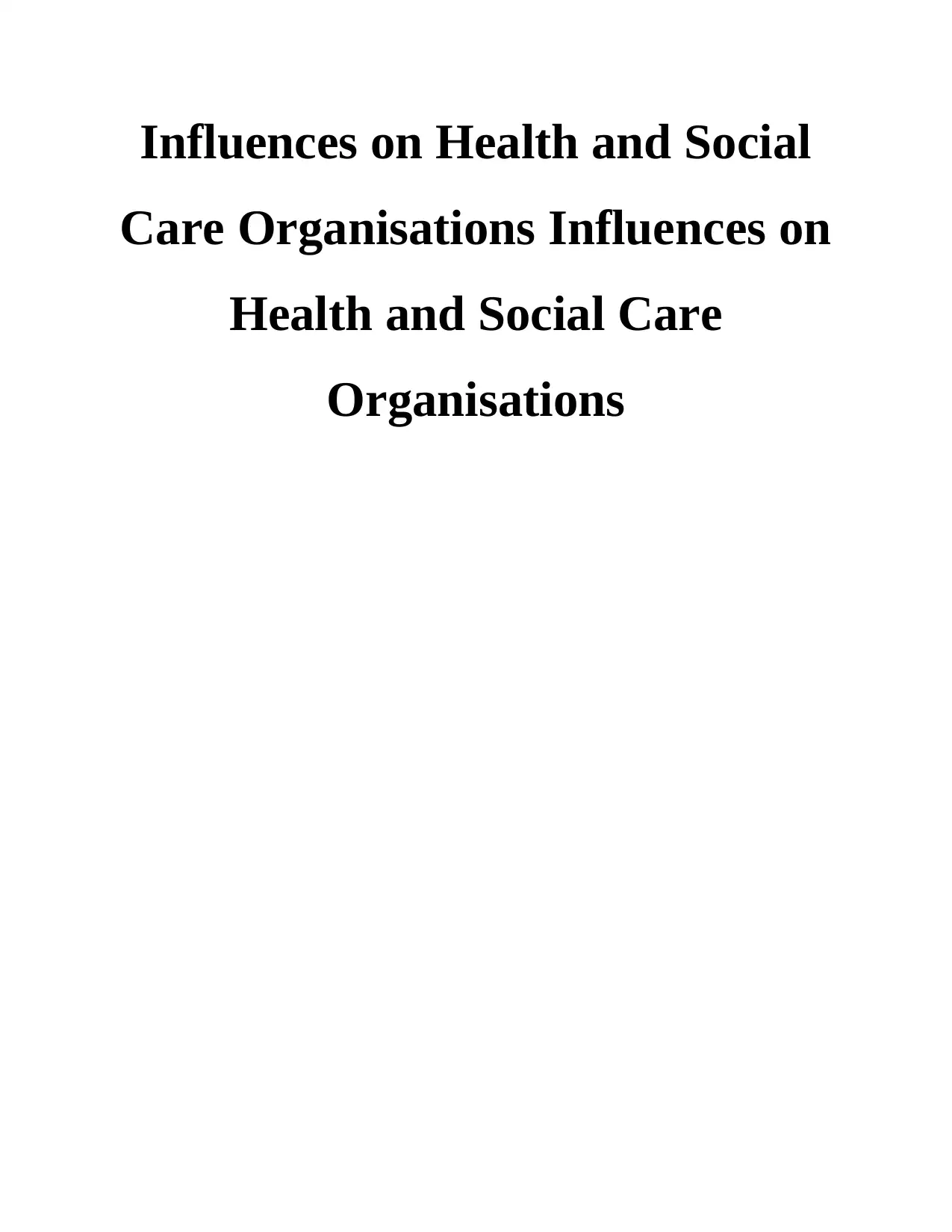
Influences on Health and Social
Care Organisations Influences on
Health and Social Care
Organisations
Care Organisations Influences on
Health and Social Care
Organisations
Paraphrase This Document
Need a fresh take? Get an instant paraphrase of this document with our AI Paraphraser
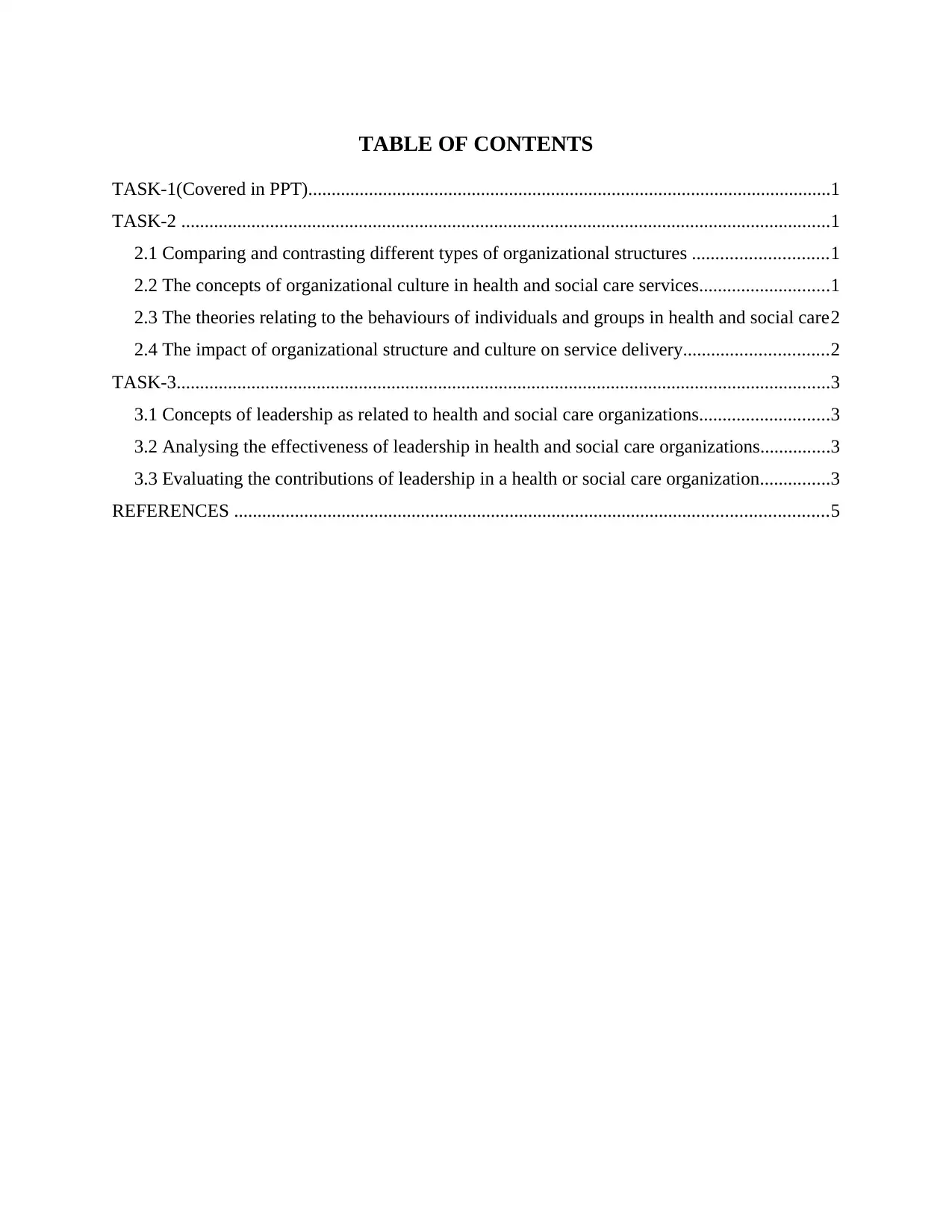
TABLE OF CONTENTS
TASK-1(Covered in PPT)................................................................................................................1
TASK-2 ...........................................................................................................................................1
2.1 Comparing and contrasting different types of organizational structures .............................1
2.2 The concepts of organizational culture in health and social care services............................1
2.3 The theories relating to the behaviours of individuals and groups in health and social care2
2.4 The impact of organizational structure and culture on service delivery...............................2
TASK-3............................................................................................................................................3
3.1 Concepts of leadership as related to health and social care organizations............................3
3.2 Analysing the effectiveness of leadership in health and social care organizations...............3
3.3 Evaluating the contributions of leadership in a health or social care organization...............3
REFERENCES ...............................................................................................................................5
TASK-1(Covered in PPT)................................................................................................................1
TASK-2 ...........................................................................................................................................1
2.1 Comparing and contrasting different types of organizational structures .............................1
2.2 The concepts of organizational culture in health and social care services............................1
2.3 The theories relating to the behaviours of individuals and groups in health and social care2
2.4 The impact of organizational structure and culture on service delivery...............................2
TASK-3............................................................................................................................................3
3.1 Concepts of leadership as related to health and social care organizations............................3
3.2 Analysing the effectiveness of leadership in health and social care organizations...............3
3.3 Evaluating the contributions of leadership in a health or social care organization...............3
REFERENCES ...............................................................................................................................5
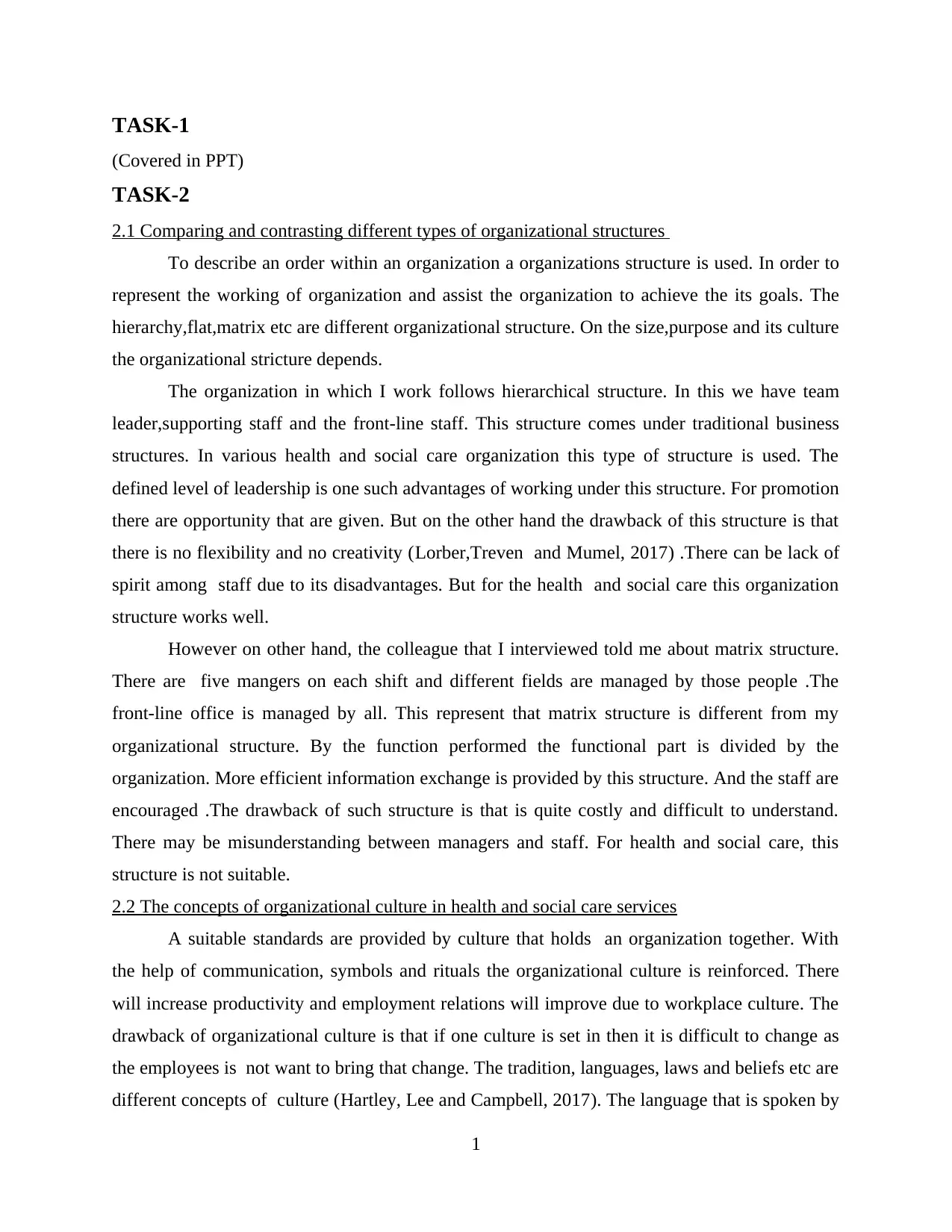
TASK-1
(Covered in PPT)
TASK-2
2.1 Comparing and contrasting different types of organizational structures
To describe an order within an organization a organizations structure is used. In order to
represent the working of organization and assist the organization to achieve the its goals. The
hierarchy,flat,matrix etc are different organizational structure. On the size,purpose and its culture
the organizational stricture depends.
The organization in which I work follows hierarchical structure. In this we have team
leader,supporting staff and the front-line staff. This structure comes under traditional business
structures. In various health and social care organization this type of structure is used. The
defined level of leadership is one such advantages of working under this structure. For promotion
there are opportunity that are given. But on the other hand the drawback of this structure is that
there is no flexibility and no creativity (Lorber,Treven and Mumel, 2017) .There can be lack of
spirit among staff due to its disadvantages. But for the health and social care this organization
structure works well.
However on other hand, the colleague that I interviewed told me about matrix structure.
There are five mangers on each shift and different fields are managed by those people .The
front-line office is managed by all. This represent that matrix structure is different from my
organizational structure. By the function performed the functional part is divided by the
organization. More efficient information exchange is provided by this structure. And the staff are
encouraged .The drawback of such structure is that is quite costly and difficult to understand.
There may be misunderstanding between managers and staff. For health and social care, this
structure is not suitable.
2.2 The concepts of organizational culture in health and social care services
A suitable standards are provided by culture that holds an organization together. With
the help of communication, symbols and rituals the organizational culture is reinforced. There
will increase productivity and employment relations will improve due to workplace culture. The
drawback of organizational culture is that if one culture is set in then it is difficult to change as
the employees is not want to bring that change. The tradition, languages, laws and beliefs etc are
different concepts of culture (Hartley, Lee and Campbell, 2017). The language that is spoken by
1
(Covered in PPT)
TASK-2
2.1 Comparing and contrasting different types of organizational structures
To describe an order within an organization a organizations structure is used. In order to
represent the working of organization and assist the organization to achieve the its goals. The
hierarchy,flat,matrix etc are different organizational structure. On the size,purpose and its culture
the organizational stricture depends.
The organization in which I work follows hierarchical structure. In this we have team
leader,supporting staff and the front-line staff. This structure comes under traditional business
structures. In various health and social care organization this type of structure is used. The
defined level of leadership is one such advantages of working under this structure. For promotion
there are opportunity that are given. But on the other hand the drawback of this structure is that
there is no flexibility and no creativity (Lorber,Treven and Mumel, 2017) .There can be lack of
spirit among staff due to its disadvantages. But for the health and social care this organization
structure works well.
However on other hand, the colleague that I interviewed told me about matrix structure.
There are five mangers on each shift and different fields are managed by those people .The
front-line office is managed by all. This represent that matrix structure is different from my
organizational structure. By the function performed the functional part is divided by the
organization. More efficient information exchange is provided by this structure. And the staff are
encouraged .The drawback of such structure is that is quite costly and difficult to understand.
There may be misunderstanding between managers and staff. For health and social care, this
structure is not suitable.
2.2 The concepts of organizational culture in health and social care services
A suitable standards are provided by culture that holds an organization together. With
the help of communication, symbols and rituals the organizational culture is reinforced. There
will increase productivity and employment relations will improve due to workplace culture. The
drawback of organizational culture is that if one culture is set in then it is difficult to change as
the employees is not want to bring that change. The tradition, languages, laws and beliefs etc are
different concepts of culture (Hartley, Lee and Campbell, 2017). The language that is spoken by
1
⊘ This is a preview!⊘
Do you want full access?
Subscribe today to unlock all pages.

Trusted by 1+ million students worldwide
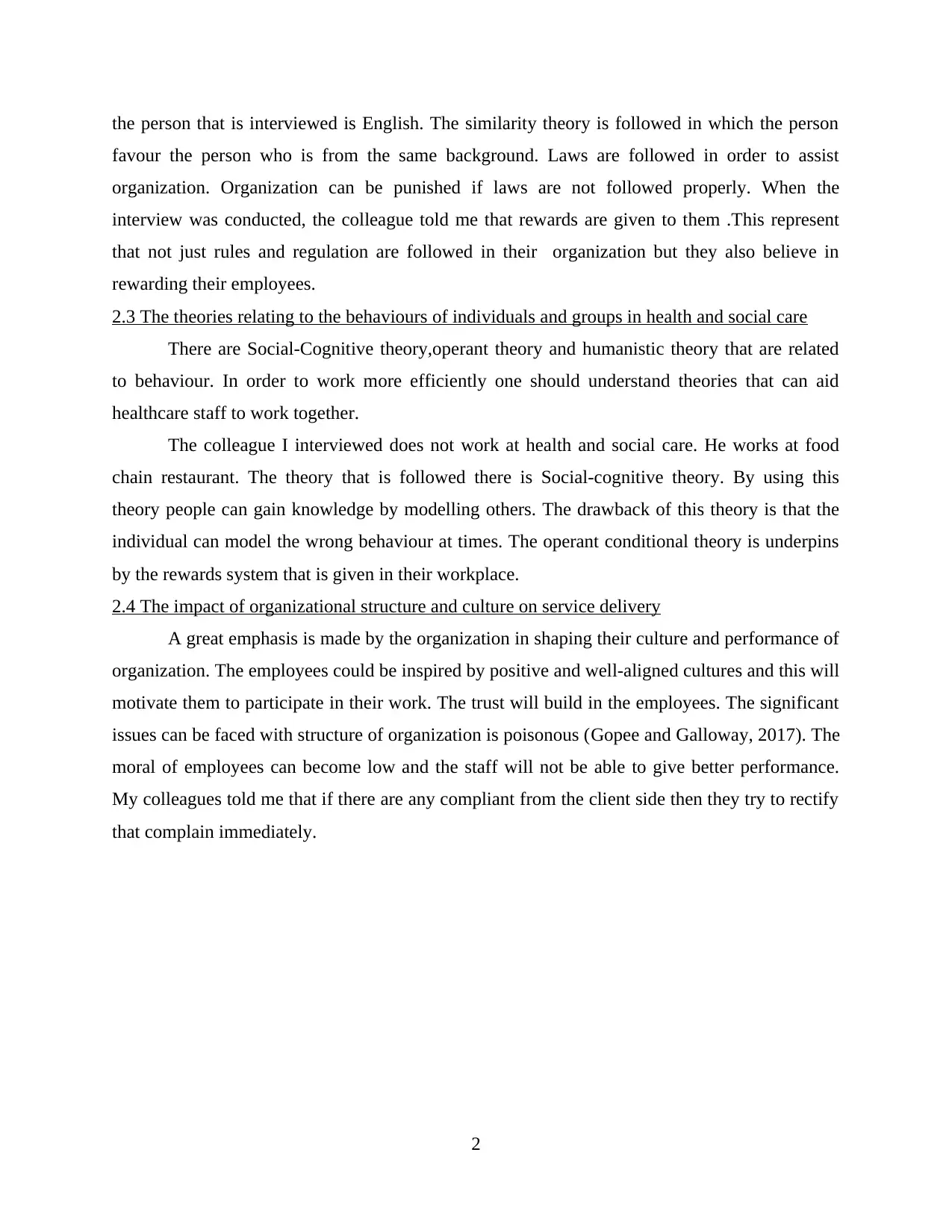
the person that is interviewed is English. The similarity theory is followed in which the person
favour the person who is from the same background. Laws are followed in order to assist
organization. Organization can be punished if laws are not followed properly. When the
interview was conducted, the colleague told me that rewards are given to them .This represent
that not just rules and regulation are followed in their organization but they also believe in
rewarding their employees.
2.3 The theories relating to the behaviours of individuals and groups in health and social care
There are Social-Cognitive theory,operant theory and humanistic theory that are related
to behaviour. In order to work more efficiently one should understand theories that can aid
healthcare staff to work together.
The colleague I interviewed does not work at health and social care. He works at food
chain restaurant. The theory that is followed there is Social-cognitive theory. By using this
theory people can gain knowledge by modelling others. The drawback of this theory is that the
individual can model the wrong behaviour at times. The operant conditional theory is underpins
by the rewards system that is given in their workplace.
2.4 The impact of organizational structure and culture on service delivery
A great emphasis is made by the organization in shaping their culture and performance of
organization. The employees could be inspired by positive and well-aligned cultures and this will
motivate them to participate in their work. The trust will build in the employees. The significant
issues can be faced with structure of organization is poisonous (Gopee and Galloway, 2017). The
moral of employees can become low and the staff will not be able to give better performance.
My colleagues told me that if there are any compliant from the client side then they try to rectify
that complain immediately.
2
favour the person who is from the same background. Laws are followed in order to assist
organization. Organization can be punished if laws are not followed properly. When the
interview was conducted, the colleague told me that rewards are given to them .This represent
that not just rules and regulation are followed in their organization but they also believe in
rewarding their employees.
2.3 The theories relating to the behaviours of individuals and groups in health and social care
There are Social-Cognitive theory,operant theory and humanistic theory that are related
to behaviour. In order to work more efficiently one should understand theories that can aid
healthcare staff to work together.
The colleague I interviewed does not work at health and social care. He works at food
chain restaurant. The theory that is followed there is Social-cognitive theory. By using this
theory people can gain knowledge by modelling others. The drawback of this theory is that the
individual can model the wrong behaviour at times. The operant conditional theory is underpins
by the rewards system that is given in their workplace.
2.4 The impact of organizational structure and culture on service delivery
A great emphasis is made by the organization in shaping their culture and performance of
organization. The employees could be inspired by positive and well-aligned cultures and this will
motivate them to participate in their work. The trust will build in the employees. The significant
issues can be faced with structure of organization is poisonous (Gopee and Galloway, 2017). The
moral of employees can become low and the staff will not be able to give better performance.
My colleagues told me that if there are any compliant from the client side then they try to rectify
that complain immediately.
2
Paraphrase This Document
Need a fresh take? Get an instant paraphrase of this document with our AI Paraphraser
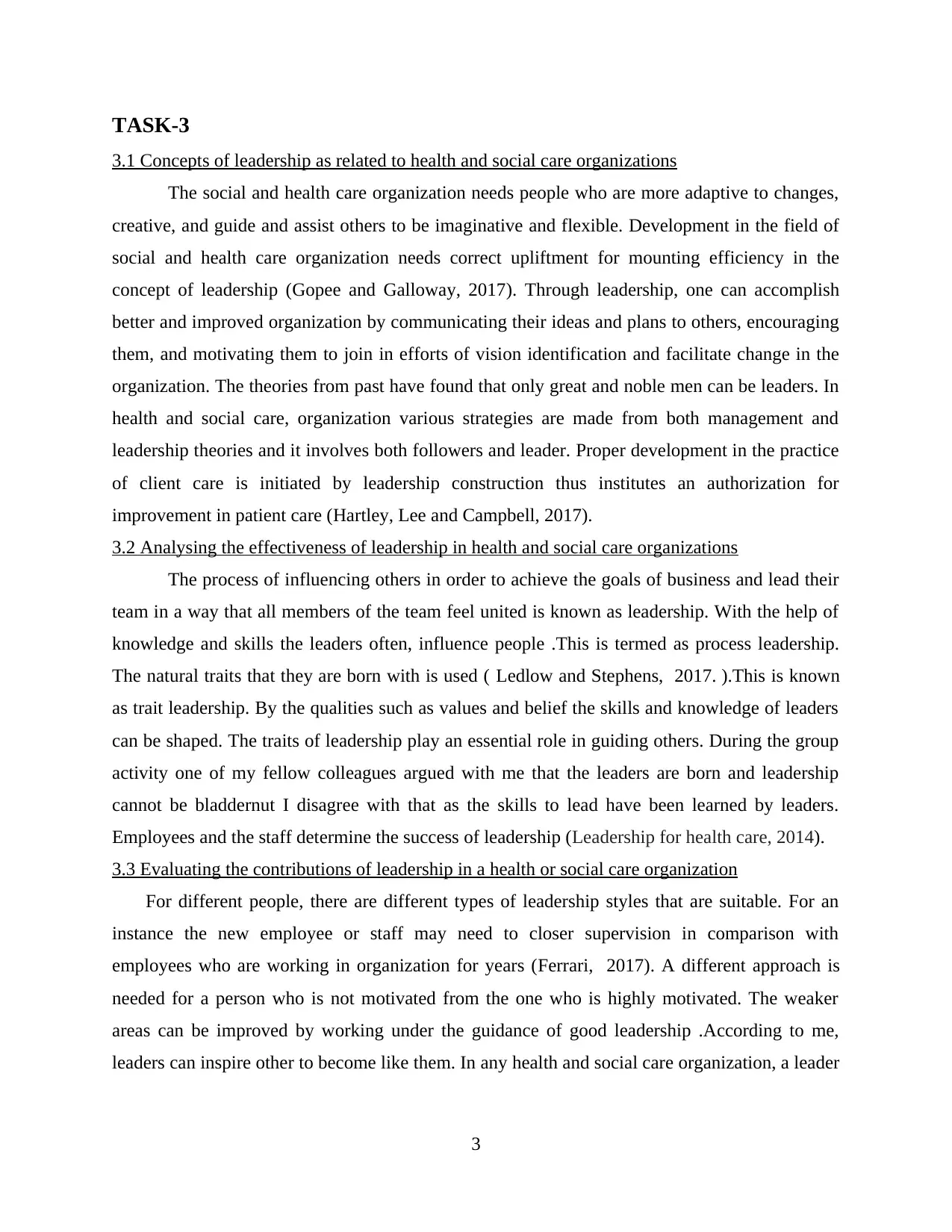
TASK-3
3.1 Concepts of leadership as related to health and social care organizations
The social and health care organization needs people who are more adaptive to changes,
creative, and guide and assist others to be imaginative and flexible. Development in the field of
social and health care organization needs correct upliftment for mounting efficiency in the
concept of leadership (Gopee and Galloway, 2017). Through leadership, one can accomplish
better and improved organization by communicating their ideas and plans to others, encouraging
them, and motivating them to join in efforts of vision identification and facilitate change in the
organization. The theories from past have found that only great and noble men can be leaders. In
health and social care, organization various strategies are made from both management and
leadership theories and it involves both followers and leader. Proper development in the practice
of client care is initiated by leadership construction thus institutes an authorization for
improvement in patient care (Hartley, Lee and Campbell, 2017).
3.2 Analysing the effectiveness of leadership in health and social care organizations
The process of influencing others in order to achieve the goals of business and lead their
team in a way that all members of the team feel united is known as leadership. With the help of
knowledge and skills the leaders often, influence people .This is termed as process leadership.
The natural traits that they are born with is used ( Ledlow and Stephens, 2017. ).This is known
as trait leadership. By the qualities such as values and belief the skills and knowledge of leaders
can be shaped. The traits of leadership play an essential role in guiding others. During the group
activity one of my fellow colleagues argued with me that the leaders are born and leadership
cannot be bladdernut I disagree with that as the skills to lead have been learned by leaders.
Employees and the staff determine the success of leadership (Leadership for health care, 2014).
3.3 Evaluating the contributions of leadership in a health or social care organization
For different people, there are different types of leadership styles that are suitable. For an
instance the new employee or staff may need to closer supervision in comparison with
employees who are working in organization for years (Ferrari, 2017). A different approach is
needed for a person who is not motivated from the one who is highly motivated. The weaker
areas can be improved by working under the guidance of good leadership .According to me,
leaders can inspire other to become like them. In any health and social care organization, a leader
3
3.1 Concepts of leadership as related to health and social care organizations
The social and health care organization needs people who are more adaptive to changes,
creative, and guide and assist others to be imaginative and flexible. Development in the field of
social and health care organization needs correct upliftment for mounting efficiency in the
concept of leadership (Gopee and Galloway, 2017). Through leadership, one can accomplish
better and improved organization by communicating their ideas and plans to others, encouraging
them, and motivating them to join in efforts of vision identification and facilitate change in the
organization. The theories from past have found that only great and noble men can be leaders. In
health and social care, organization various strategies are made from both management and
leadership theories and it involves both followers and leader. Proper development in the practice
of client care is initiated by leadership construction thus institutes an authorization for
improvement in patient care (Hartley, Lee and Campbell, 2017).
3.2 Analysing the effectiveness of leadership in health and social care organizations
The process of influencing others in order to achieve the goals of business and lead their
team in a way that all members of the team feel united is known as leadership. With the help of
knowledge and skills the leaders often, influence people .This is termed as process leadership.
The natural traits that they are born with is used ( Ledlow and Stephens, 2017. ).This is known
as trait leadership. By the qualities such as values and belief the skills and knowledge of leaders
can be shaped. The traits of leadership play an essential role in guiding others. During the group
activity one of my fellow colleagues argued with me that the leaders are born and leadership
cannot be bladdernut I disagree with that as the skills to lead have been learned by leaders.
Employees and the staff determine the success of leadership (Leadership for health care, 2014).
3.3 Evaluating the contributions of leadership in a health or social care organization
For different people, there are different types of leadership styles that are suitable. For an
instance the new employee or staff may need to closer supervision in comparison with
employees who are working in organization for years (Ferrari, 2017). A different approach is
needed for a person who is not motivated from the one who is highly motivated. The weaker
areas can be improved by working under the guidance of good leadership .According to me,
leaders can inspire other to become like them. In any health and social care organization, a leader
3
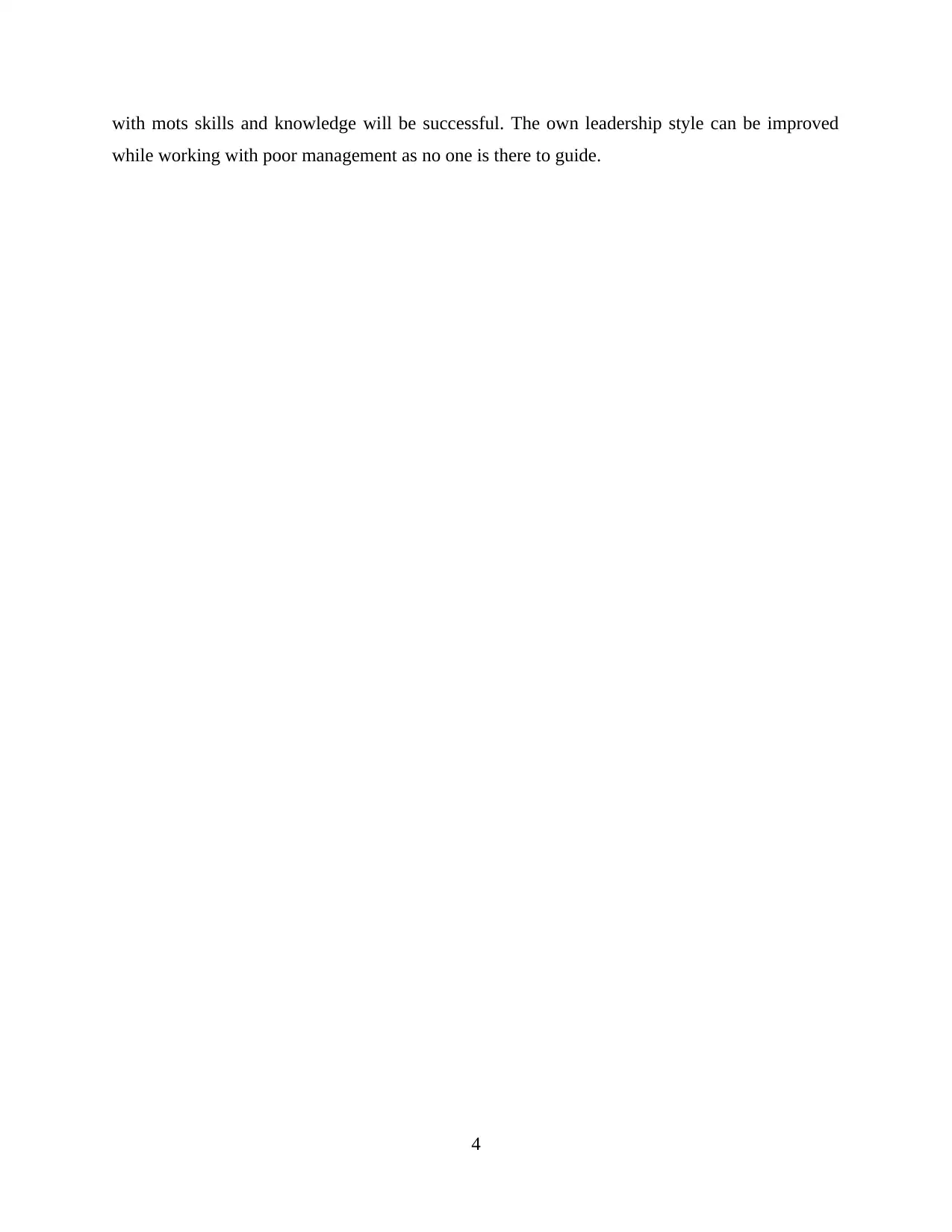
with mots skills and knowledge will be successful. The own leadership style can be improved
while working with poor management as no one is there to guide.
4
while working with poor management as no one is there to guide.
4
⊘ This is a preview!⊘
Do you want full access?
Subscribe today to unlock all pages.

Trusted by 1+ million students worldwide
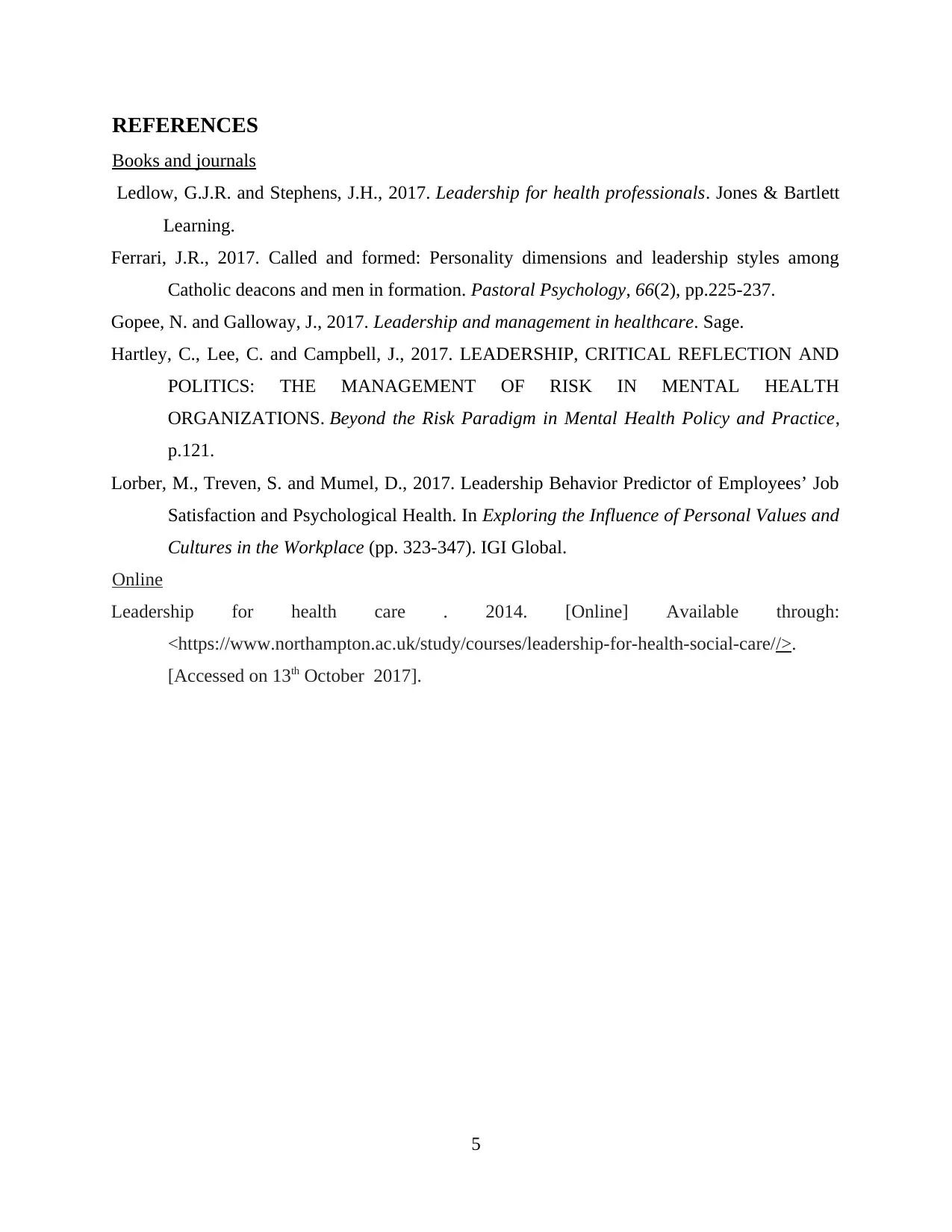
REFERENCES
Books and journals
Ledlow, G.J.R. and Stephens, J.H., 2017. Leadership for health professionals. Jones & Bartlett
Learning.
Ferrari, J.R., 2017. Called and formed: Personality dimensions and leadership styles among
Catholic deacons and men in formation. Pastoral Psychology, 66(2), pp.225-237.
Gopee, N. and Galloway, J., 2017. Leadership and management in healthcare. Sage.
Hartley, C., Lee, C. and Campbell, J., 2017. LEADERSHIP, CRITICAL REFLECTION AND
POLITICS: THE MANAGEMENT OF RISK IN MENTAL HEALTH
ORGANIZATIONS. Beyond the Risk Paradigm in Mental Health Policy and Practice,
p.121.
Lorber, M., Treven, S. and Mumel, D., 2017. Leadership Behavior Predictor of Employees’ Job
Satisfaction and Psychological Health. In Exploring the Influence of Personal Values and
Cultures in the Workplace (pp. 323-347). IGI Global.
Online
Leadership for health care . 2014. [Online] Available through:
<https://www.northampton.ac.uk/study/courses/leadership-for-health-social-care//>.
[Accessed on 13th October 2017].
5
Books and journals
Ledlow, G.J.R. and Stephens, J.H., 2017. Leadership for health professionals. Jones & Bartlett
Learning.
Ferrari, J.R., 2017. Called and formed: Personality dimensions and leadership styles among
Catholic deacons and men in formation. Pastoral Psychology, 66(2), pp.225-237.
Gopee, N. and Galloway, J., 2017. Leadership and management in healthcare. Sage.
Hartley, C., Lee, C. and Campbell, J., 2017. LEADERSHIP, CRITICAL REFLECTION AND
POLITICS: THE MANAGEMENT OF RISK IN MENTAL HEALTH
ORGANIZATIONS. Beyond the Risk Paradigm in Mental Health Policy and Practice,
p.121.
Lorber, M., Treven, S. and Mumel, D., 2017. Leadership Behavior Predictor of Employees’ Job
Satisfaction and Psychological Health. In Exploring the Influence of Personal Values and
Cultures in the Workplace (pp. 323-347). IGI Global.
Online
Leadership for health care . 2014. [Online] Available through:
<https://www.northampton.ac.uk/study/courses/leadership-for-health-social-care//>.
[Accessed on 13th October 2017].
5
1 out of 7
Related Documents
Your All-in-One AI-Powered Toolkit for Academic Success.
+13062052269
info@desklib.com
Available 24*7 on WhatsApp / Email
![[object Object]](/_next/static/media/star-bottom.7253800d.svg)
Unlock your academic potential
Copyright © 2020–2025 A2Z Services. All Rights Reserved. Developed and managed by ZUCOL.





